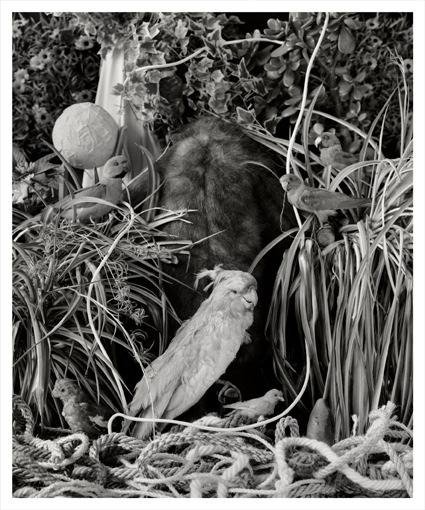Hartmut Neumann
dal 19/7/2012 al 6/10/2012
Segnalato da
19/7/2012
Hartmut Neumann
Alfred Ehrhardt Stiftung, Berlin
With and By Nature. New Photographs. The historical photographs and films of Alfred Ehrhardt are shown together with works by contemporary photographers addressing the concepts of nature and the natural. He constructs an image of nature that appears puzzlingly alien, although it is compiled of recognizably natural forms.

Hartmut Neumann’s abstract, sculptural, utopian, and staged view of nature offers an inherent
frame of reference for the works of Alfred Ehrhardt, which the artist used as a basis when
conceiving this exhibition specifically for the Alfred Ehrhardt Foundation. Neumann thus makes a
new contribution the dialogical approach underlying the foundation’s exhibitions, in which the
historical photographs and films of Alfred Ehrhardt are shown together with works by
contemporary photographers addressing the concepts of nature and the natural.
Hartmut Neumann creates assemblage-like compositions of taxidermized animals, plant
elements, natural materials, and man-made objects—visual worlds of alarming artificiality. He
constructs an image of nature that appears puzzlingly alien, although it is compiled of
recognizably natural forms. He creates absurd visual environments vacillating between
abstraction and representation. Stuffed finches and titmice hide in ice grottos made of sprayed
mounds of building foam; parakeets breed in front of a wall created out of plastic plants and
animal fur. Styrofoam balls and plastic rings mutate into a stellar constellation within a deep
black cosmos. A focus of the exhibition is works dealing with the theme of the cosmos. Both in
his paintings as well as his photographs, the artist constructs extraterrestrial worlds of forms
and objects, whose cosmological sensibility emerges from the relationship between the gathered
objects. Once Neumann has photographed his arrangements, these compositions are then
destroyed and are thus only preserved via the medium of photography.
The sheer inexhaustible wealth of his formal repertoire is based on the notion of the chamber of
art and curiosities, the Wunderkammer, in which “artificialia” and “naturalia” are shown side by
side to suggest a microcosm of the universe. Also natural-historical dioramas and illustrations of
nature in historical reference books have inspired the artist’s formal language. His own collection
of taxidermized animals, compiled over decades, serves as a source of motifs, which are then
enhanced by additional props of natural origin, a wide variety of objects made from different
materials, and many everyday objects. Neumann’s enigmatic compositions are characterized by
opulence and an exuberant wealth of detail. Conveying a rare sense of madness, his theatrical
natural scenarios make a deep impression. Shaped by preparators, the skins, feathers, and furs
of dead beings convey a feeling of the uncanny. The animals’ staring gazes, their mangy fur, the
immobility of their animated poses intended to suggest natural movement as well as the frozen
nature of the photographic image—all this make us shudder. The artistic composition of these
natural artifacts keep the dead alive like a relict and infuses them with a second, artificial breath
of life.
The utopian gardens populated by native and exotic animals describe a paradisiacal world void
of human kind. The artist becomes a (re-)creator or worlds, and herein manifests the oldest
contest between the artist and the hand of nature. However, Neumann’s incredibly fascinating
and unsettling images are anything but representational renderings of nature or images of an
untouched natural paradise. These are artifacts and constructions, which foreground a sense of
artificiality through the media of painting, graphic works, sculpture, and photography. In 1999
Stephan Berg wrote that Neumann “has a boundless interest in turning everything, completely
everything, into painting, thus completely sacrificing scale, proportion, and painterly
convention,” and the same applies in the reduction of his sculptural object-assemblages to the
two-dimensional black and white surface of the photograph. Photography offers him the freedom
to examine apparently suspicious topics without constraint and without deferring to visual
convention.
Hartmut Neumann, born in 1954 in Delmenhorst, studied at the University of the Arts Bremen
with Prof. Rolf Thiele. 1983 “Junger Westen” Art Prize, 1985/86 Villa Massimo stipend, 1988
Deutscher Künstlerbund Art Prize. Numerous group and solo exhibitions (including
Kunstmuseum Düsseldorf 1991, Kunsthalle Recklinghausen 1992, Ludwig Forum Aachen 1998,
Von der Heydt-Museum Wuppertal 2000, Herzog-Anton-Ulrich-Museum Braunschweig 2003,
Forum Kunst Rottweil 2009). Since 1992 Professor for Painting at the Braunschweig University of
the Arts.
In cooperation with Sabine Schmidt Galerie, Cologne
Image: Hartmut Neumann, Der Höhlenbrüter (Vogellandschaft), 2009. 80 x 66cm, Pigmentdruck auf Barytpapier © Hartmut Neumann / VG Bild-Kunst, Bonn
Project-based PR:
artpress – Ute Weingarten l Elisabethkirchstr. 15l 10115 Berlin l
Tel: +49 (0)30-21 96 18 43 l E-Mail: artpress@uteweingarten.de
Opening: Friday, July 20 2012, 7:00 pm. The artist will be present. Opening speech: Dr. Christiane Stahl, Director, Alfred Ehrhardt Foundation
Alfred Ehrhardt Stiftung
Auguststr. 75 l 10117 Berlin
Opening hours: Tues to Sun 11:00 am – 6:00 pm, Thurs 11:00 am – 9:00 pm



